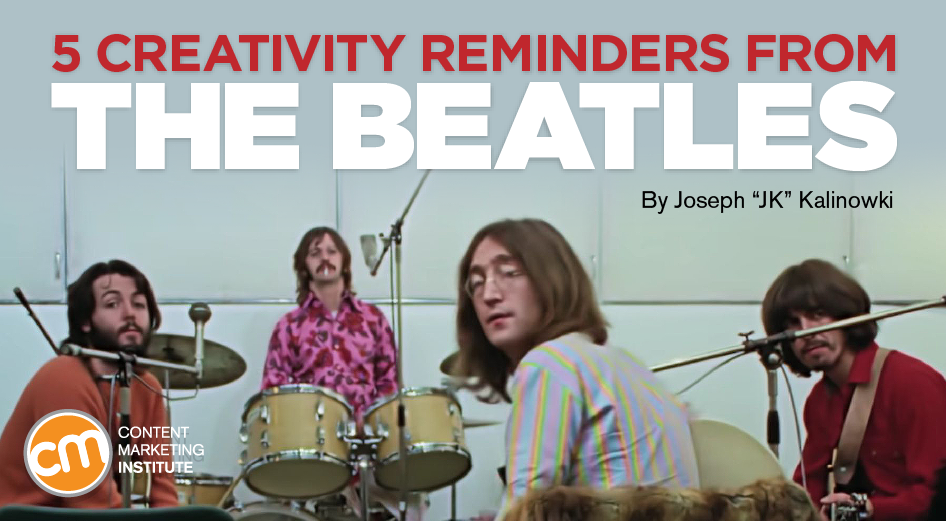
Like millions of people, I sat glued to my screen for Peter Jackson’s nearly nine-hour, three-part documentary, The Beatles: Get Back. The series comes from more than 60 hours of video and 156 hours of audio recordings originally captured by director Michael Lindsay-Hogg.
The team behind the Disney+ show spent years editing the original archival footage to create the 2021 version of the film, which Jackson deemed a “documentary about a documentary.” For a Beatles fan – or any fan of the creative process – Hogg captured creative gold.
I grew up with The Beatles. I started listening to my pop’s collection of records on my “The Fonz” record player in elementary school. Eventually, The Beatles catalog became the songbook of my life, even during my rebellious, long-haired, first-tattoo, grunge-rock years. I stood in line at my college record store to buy Pearl Jam Vitalogy and The Beatles Live at the BBC at the same time.
For me, watching the documentary felt like a gift. I’d like to give you a few creative takeaways that occurred to me while watching. Whether you’re a long-time Beatles fan, a casual listener, or simply someone curious about the creative process, you’ll find something to apply to your own endeavors.
Watching The Beatles: Get Back from @DisneyStudios felt like a gift for @JKKalinowski. He’s giving back five creativity takeaways for all #content creators (via @CMIcontent). Click To Tweet
I, me, mine doesn’t work for collaboration
The John Lennon and Paul McCartney partnership earned most of the songwriting credits in The Beatles’ catalog. And the documentary shows the duo’s creative dominance for better – you see the affection and connection fueling their collaboration – and for worse – you see them ignore or downplay George Harrison’s suggestions and songs (including, initially, I Me Mine).
What The Beatles did: The group wildly underestimated George as a songwriter and producer. His creative frustration led to his departure from the band during the sessions. When he returned, he played an early version of his song All Things Must Pass for John and Paul. They passed on it. George later released the song on his solo triple album All Things Must Pass, which met critical acclaim and sold millions of copies.
What you can do: Don’t underestimate the people on your team. Encourage creative ideas from everyone regardless of role or title. Anyone can come up with ideas that deserve consideration (even Ringo Starr, who gets help from George on Octopus’s Garden during the documentary.)
Don’t be like McCartney and Lennon. Give your George Harrison a chance to contribute great ideas to your #ContentMarketing, says @JKKalinowski (via @CMIcontent) Click To Tweet
When you’ve got a feeling, pay attention (it usually won’t let you down)
While rehearsing for their upcoming recording, the band members agreed something was missing in many of the songs, but they couldn’t put their finger on what. They bickered about the compositions and played the music over and over, but they couldn’t fix the problem.
One day, renowned session keyboardist Billy Preston stopped by Apple Studios to say hello. The artists knew each other from time spent in Hamburg earlier in their careers. (The Beatles opened for Little Richard’s touring band in which Billy played.)
What The Beatles did: The lads from Liverpool invited Billy to sit in with them – and found their missing piece. Billy’s contributions on the electric organ served as the catalyst that fired up the process and helped The Beatles finish the compositions. Billy is listed as a featured performer on the Get Back single, marking the only time another artist was credited as a co-performer on a Beatles song.
What you can do: Sometimes, fresh voices can breathe new life and energy into an idea. When you’re stuck, bring someone new – a colleague from another department or a member of your audience – into the process. A new ingredient can change the whole flavor of your project.
Get back to old ideas
The documentary shows Paul McCartney, John Lennon, and George Harrison giving a fresh spin to songs they had written years before. For example, the song One After 909 was written as early as 1957 but wasn’t recorded until 1969.
What The Beatles did: Throughout the series, Paul sings bits of songs that never made it onto the group’s albums. But he kept working on them, and they eventually made their way onto his post-Beatles solo albums. John demoed a song he called Child of Nature, which ultimately became his hit Jealous Guy on Imagine.
What you can do: Never throw your ideas away – just put them on a figurative shelf. If you have an idea that just doesn’t work today, put it away and come back to it later.
Move over once
The Beatles first planned to film the documentary about creating an album from scratch in 14 days at Twickenham Film Studios. But the set turned out to lack the appropriate acoustics, and the cold temperatures in the mostly empty space made the band miserable.
What The Beatles did: They changed locations. After George left the band, one condition of his return included a move away from Twickenham. Once the band settled into their more intimate (and purpose-built) space in Apple Studios, the energy among the four changed for the better.
What you can do: If you feel stifled by the parameters you’re working in, change them. If you can’t change them completely, toe the line of breaking away from them. (I think there’s a cliché about a box and thinking that applies).
Move over twice
The recording location change wasn’t the only (or biggest) adaption in the original vision. The original plan included The Beatles performing in front of a live audience, which they hadn’t done in years. But they hadn’t settled on a location.
What The Beatles did: Eventually, the band agreed to perform (and record some of the album’s songs) live on the roof of their studio building. It wasn’t the concert initially planned, but they got great performances (and great footage) from the switch.
What you can do: Stay open. When circumstances change, don’t immediately fight them. Let it be – and see if you can work with the new constraints or requirements. You might find it’s a breath of fresh air.
Be like The Beatles. No live concert or conference? Take a creative approach to work within your #ContentMarketing constraints (rooftop meeting, anyone?), says @JKKalinowski via @CMIcontent. Click To Tweet
Let your thoughts meander
The most important reminders I took from the hours I spent watching are:
- Keep your eyes, ears, and mind open – creative ideas can come from anywhere and anyone.
- Noodle on your ideas over time.
- Let yourself have fun and enjoy the process.
Soon you’ll create something you’re proud to send out across the universe.
Did you watch The Beatles: Get Back? I’d love to hear your thoughts about it or about creativity. Leave me a note in the comments.
Cover image by Joseph Kalinowski/Content Marketing Institute




